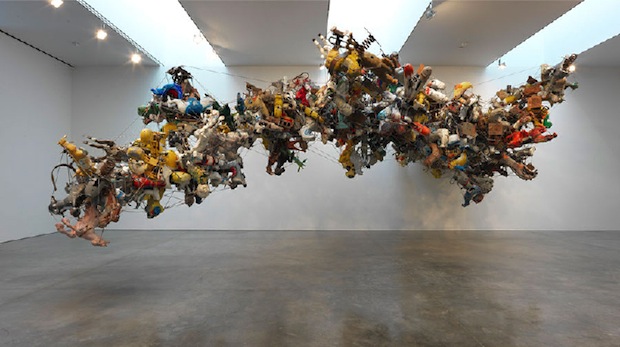Nancy Rubins, “Our Friend Fluid Metal”
Gagosian Gallery
522 West 21st Street
What’s on view: Enormous clouds of spring-mounted playground horses, bound together with steel cables, suspended from the ceiling and standing as sculptures. Also, an enormous wall-mounted drawing made to look like scrap metal after being painstakingly covered in pencil rubbings.
Whitney: Gagosian’s doing video specials now! They are awkward and tedious.
Corinna: Everyone looks so happy in the Jeff Koons video. It’s like “Split-Rocker” made New York a better place to live!
Whitney: Jeff Koons kinda smiles and somebody takes a picture. And flowers! Tra la la.
As for Nancy Rubins’s interview, it doesn’t answer many of my questions about the work, but does elaborate on her interest in the timelessness of metal, which is constantly in flux between being melted down to make something new. That would explain why she makes these cluster sculptures out of anything from bouncey horses, to spare airplane parts, to boats, to mobile homes. I dunno. Ephemerality is a lot less noticeable than the fact that these look like tinker toy sculptures made by giants. It’s a cool thing to do with a lot of leftover horses. Again, Miley Cyrus’s artist statement comes to mind: “I had a bunch of fucking junk and shit, and so instead of letting it be junk and shit, I turned it into something that made me happy.”
Paddy: Yeah, I mean fair enough. But then again, why does everything have to boil down to material history as if the subject itself were meaningless? Does an artist have no other social responsibility than to make themselves happy? I don’t want it to seem like I begrudge doing the things that make you happy, but frankly, that isn’t enough. It’s ultimately a very detached and privileged way of living in the world.
By the sounds of the video interview, she dithered for years about the content of horses, and then finally decided that, actually, she’s just interested in the history of material transformation, so what does it matter what does their original use matter anyway?
But that rationale doesn’t hold up. If we look at Paul B. Davis’s datamoshing video of the Cremaster series, for example, do we believe that the Barney reference means nothing just because the artist’s interest is in breaking down that material? Of course not (and he says so himself). You can’t erase the meaning of an object just because you don’t care about it.
If the point just before material transformation is so important, why isn’t that made more apparent? You see some of that transformation in her paper drawings that resemble steel —though there’s only one in this show and it’s shoved in Gagosian-sized closet (in other words, a small room). The rest of the show is a bunch of bouncy horses bound together with cable, which seems pretty thoughtless. And from everything she tells us, that’s because it is.




Comments on this entry are closed.